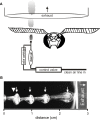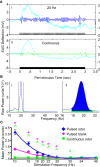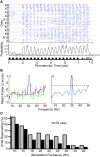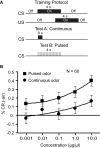Odors Pulsed at Wing Beat Frequencies are Tracked by Primary Olfactory Networks and Enhance Odor Detection
- PMID: 20407584
- PMCID: PMC2854572
- DOI: 10.3389/neuro.03.001.2010
Odors Pulsed at Wing Beat Frequencies are Tracked by Primary Olfactory Networks and Enhance Odor Detection
Abstract
Each down stroke of an insect's wings accelerates axial airflow over the antennae. Modeling studies suggest that this can greatly enhance penetration of air and air-born odorants through the antennal sensilla thereby periodically increasing odorant-receptor interactions. Do these periodic changes result in entrainment of neural responses in the antenna and antennal lobe (AL)? Does this entrainment affect olfactory acuity? To address these questions, we monitored antennal and AL responses in the moth Manduca sexta while odorants were pulsed at frequencies from 10-72 Hz, encompassing the natural wingbeat frequency. Power spectral density (PSD) analysis was used to identify entrainment of neural activity. Statistical analysis of PSDs indicates that the antennal nerve tracked pulsed odor up to 30 Hz. Furthermore, at least 50% of AL local field potentials (LFPs) and between 7-25% of unitary spiking responses also tracked pulsed odor up to 30 Hz in a frequency-locked manner. Application of bicuculline (200 muM) abolished pulse tracking in both LFP and unitary responses suggesting that GABA(A) receptor activation is necessary for pulse tracking within the AL. Finally, psychophysical measures of odor detection establish that detection thresholds are lowered when odor is pulsed at 20 Hz. These results suggest that AL networks can respond to the oscillatory dynamics of stimuli such as those imposed by the wing beat in a manner analogous to mammalian sniffing.
Keywords: GABA; antennal lobe; olfaction; olfactory bulb; oscillations; sensory sampling; sniffing; synchrony.
Figures






Similar articles
-
Antennal lobe representations are optimized when olfactory stimuli are periodically structured to simulate natural wing beat effects.Front Cell Neurosci. 2014 Jun 12;8:159. doi: 10.3389/fncel.2014.00159. eCollection 2014. Front Cell Neurosci. 2014. PMID: 24971052 Free PMC article.
-
Detailed Characterization of Local Field Potential Oscillations and Their Relationship to Spike Timing in the Antennal Lobe of the Moth Manduca sexta.Front Neuroeng. 2011 Oct 25;4:12. doi: 10.3389/fneng.2011.00012. eCollection 2011. Front Neuroeng. 2011. PMID: 22046161 Free PMC article.
-
Odor detection in Manduca sexta is optimized when odor stimuli are pulsed at a frequency matching the wing beat during flight.PLoS One. 2013 Nov 21;8(11):e81863. doi: 10.1371/journal.pone.0081863. eCollection 2013. PLoS One. 2013. PMID: 24278463 Free PMC article.
-
Morphology and physiology of the olfactory system of blood-feeding insects.J Physiol Paris. 2014 Apr-Jun;108(2-3):96-111. doi: 10.1016/j.jphysparis.2014.04.006. Epub 2014 May 15. J Physiol Paris. 2014. PMID: 24836537 Review.
-
GABAergic mechanisms that shape the temporal response to odors in moth olfactory projection neurons.Ann N Y Acad Sci. 1998 Nov 30;855:475-81. doi: 10.1111/j.1749-6632.1998.tb10608.x. Ann N Y Acad Sci. 1998. PMID: 9929641 Review.
Cited by
-
Space Takes Time: Concentration Dependent Output Codes from Primary Olfactory Networks Rapidly Provide Additional Information at Defined Discrimination Thresholds.Front Cell Neurosci. 2016 Jan 14;9:515. doi: 10.3389/fncel.2015.00515. eCollection 2015. Front Cell Neurosci. 2016. PMID: 26834563 Free PMC article.
-
Pheromone transduction in moths.Front Cell Neurosci. 2010 Dec 31;4:133. doi: 10.3389/fncel.2010.00133. eCollection 2010. Front Cell Neurosci. 2010. PMID: 21228914 Free PMC article.
-
Insect-controlled Robot: A Mobile Robot Platform to Evaluate the Odor-tracking Capability of an Insect.J Vis Exp. 2016 Dec 19;(118):54802. doi: 10.3791/54802. J Vis Exp. 2016. PMID: 28060258 Free PMC article.
-
Antennal lobe representations are optimized when olfactory stimuli are periodically structured to simulate natural wing beat effects.Front Cell Neurosci. 2014 Jun 12;8:159. doi: 10.3389/fncel.2014.00159. eCollection 2014. Front Cell Neurosci. 2014. PMID: 24971052 Free PMC article.
-
High-speed odor transduction and pulse tracking by insect olfactory receptor neurons.Proc Natl Acad Sci U S A. 2014 Nov 25;111(47):16925-30. doi: 10.1073/pnas.1412051111. Epub 2014 Nov 10. Proc Natl Acad Sci U S A. 2014. PMID: 25385618 Free PMC article.
References
Grants and funding
LinkOut - more resources
Full Text Sources

